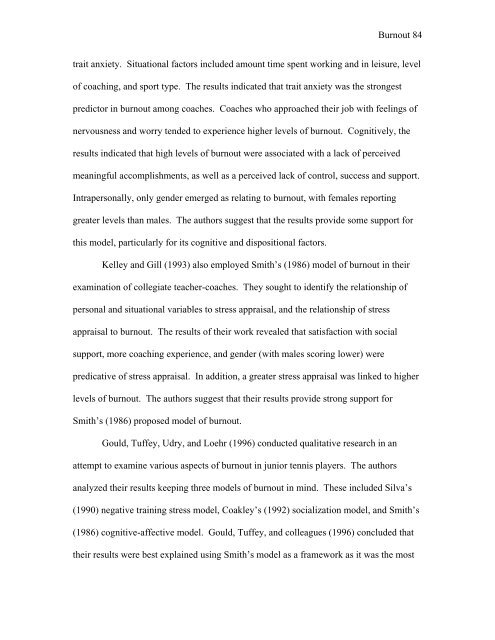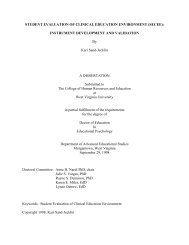Coach and Athlete Burnout - West Virginia University
Coach and Athlete Burnout - West Virginia University
Coach and Athlete Burnout - West Virginia University
Create successful ePaper yourself
Turn your PDF publications into a flip-book with our unique Google optimized e-Paper software.
<strong>Burnout</strong> 84<br />
trait anxiety. Situational factors included amount time spent working <strong>and</strong> in leisure, level<br />
of coaching, <strong>and</strong> sport type. The results indicated that trait anxiety was the strongest<br />
predictor in burnout among coaches. <strong>Coach</strong>es who approached their job with feelings of<br />
nervousness <strong>and</strong> worry tended to experience higher levels of burnout. Cognitively, the<br />
results indicated that high levels of burnout were associated with a lack of perceived<br />
meaningful accomplishments, as well as a perceived lack of control, success <strong>and</strong> support.<br />
Intrapersonally, only gender emerged as relating to burnout, with females reporting<br />
greater levels than males. The authors suggest that the results provide some support for<br />
this model, particularly for its cognitive <strong>and</strong> dispositional factors.<br />
Kelley <strong>and</strong> Gill (1993) also employed Smith’s (1986) model of burnout in their<br />
examination of collegiate teacher-coaches. They sought to identify the relationship of<br />
personal <strong>and</strong> situational variables to stress appraisal, <strong>and</strong> the relationship of stress<br />
appraisal to burnout. The results of their work revealed that satisfaction with social<br />
support, more coaching experience, <strong>and</strong> gender (with males scoring lower) were<br />
predicative of stress appraisal. In addition, a greater stress appraisal was linked to higher<br />
levels of burnout. The authors suggest that their results provide strong support for<br />
Smith’s (1986) proposed model of burnout.<br />
Gould, Tuffey, Udry, <strong>and</strong> Loehr (1996) conducted qualitative research in an<br />
attempt to examine various aspects of burnout in junior tennis players. The authors<br />
analyzed their results keeping three models of burnout in mind. These included Silva’s<br />
(1990) negative training stress model, Coakley’s (1992) socialization model, <strong>and</strong> Smith’s<br />
(1986) cognitive-affective model. Gould, Tuffey, <strong>and</strong> colleagues (1996) concluded that<br />
their results were best explained using Smith’s model as a framework as it was the most












